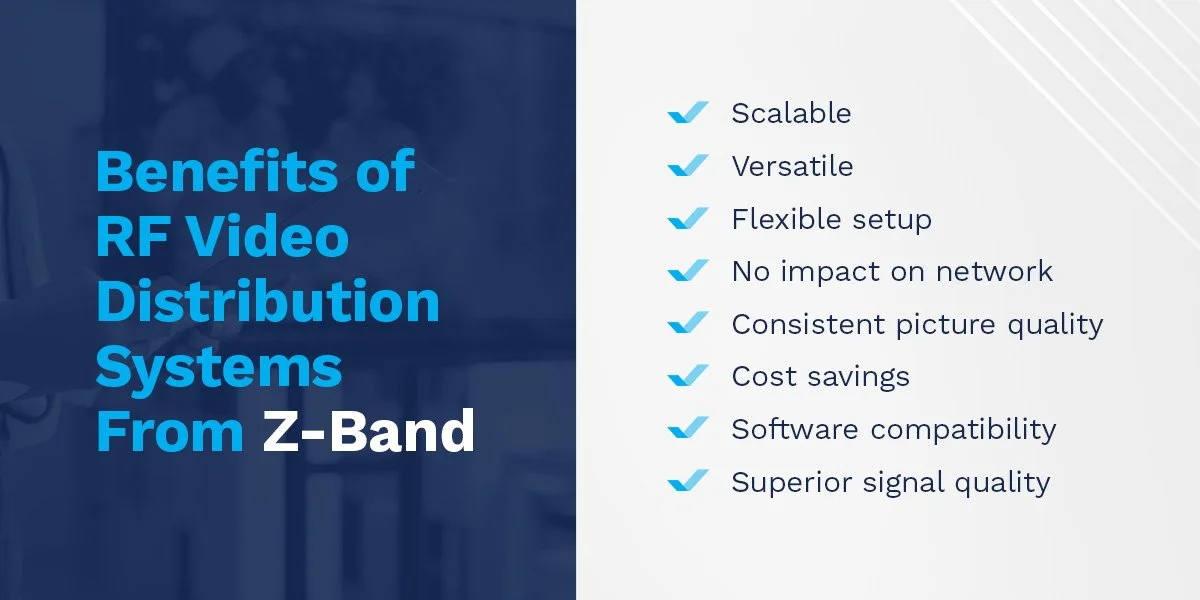Your Guide to RF Video Distribution Systems
Radio frequency (RF) technology transmits and receives information using electromagnetic waves within the RF spectrum. It is a tried-and-true invention that enables everything from MRIs and air traffic control to broadcast television.
Governments, schools, healthcare facilities and other commercial organizations with many TVs can benefit from RF video distribution systems.
What Is RF Video?
RF video transmits video and audio signals, typically through a coaxial cable but sometimes through a category (CAT) cable. Cable TV is an example of RF video — RF modulators convert signals and broadcast them on a specific RF, transmitted through coaxial cables to reach a television. Unlike other similar technologies, such as Internet Protocol (IP) technologies, RF video does not require a network connection. Additionally, RF systems broadcast their TV channels on a U.S. quadrature amplitude modulation (QAM) carrier, unlike IP and streaming solutions, which use data.
What Is RF Video Distribution?
RF video distribution exists on a larger scale and is essentially a building's private cable TV network. Organizations can send the same feed to dozens, hundreds or thousands of TVs. For example, a hospital might display videos of wait times on TVs placed in waiting areas and in patient rooms.
There are two types of RF video distribution systems:
Active systems: These systems have components that communicate, which makes them easier to set up and more scalable.
Passive systems: In these systems, each component functions as a stand-alone device, making setup a series of manual adjustments and calculations for each TV drop. They are typically better for smaller networks with only a few TVs.
Commercial Applications for RF Video
Numerous industries can benefit from RF video distribution systems, including:
Healthcare facilities: Distribute high-quality video to employee lounges, waiting areas and patient rooms.
Government and military institutions: Use televisions to show training videos and display alerts. Look for products that are Trade Agreement Act (TAA) compliant and General Services Administration (GSA) listed.
Schools and educational institutions: Distribute campus-wide announcements on TVs or show prerecorded lectures.
Hospitality businesses: Hotels, resorts and casinos can use RF video distribution systems to display current promotions, restaurant options and upcoming events.
Corporate businesses: Relay video messages to employees and visitors in a commercial office space.
Religious events: Broadcast prerecorded sermons to satellite locations to keep everyone on the same page.
Z-Band Technologies RF Video Distribution System
Z-Band Technologies offers a twist on traditional passive RF video distribution systems by eliminating the coaxial cable and relying instead on a category 5e or 6 unshielded twisted pair (UTP) cable. CAT 6 cables offer twice the bandwidth of CAT 5e cables, making them a better choice for most organizations.
Our active system uses two main components:
Z-Distribution ZHC HUBUp to 24-port one-piece master unitZ-BalunFree-hanging, wall-mounted device that converts between a balanced and unbalanced signal
Together, the devices transmit the entire RF video spectrum using one piece of CAT cable. The hub converts the RF signal to travel along the category cable to the endpoint, and the balun converts the signal back into RF to feed into TVs. There is constant communication between the two devices, ensuring consistent picture quality with minimal maintenance.
It's cable television for a new era, perfect for new construction, renovations or retrofits.
Benefits of RF Video Distribution Systems From Z-Band
Our video over category cable solution is ideal if you want reliable high-definition (HD) video content, without the coax. Here are some of the benefits of our Z-TV system:
Scalable: With a system like this, users can connect to up to 14,000 TVs. If your organization expands rapidly, it's easy to add units to expand the Z-TV system.
Versatile: Synchronize video streaming of live or recorded events across multiple devices.
Flexible setup: You only need one piece of structured Ethernet cable, allowing for simple system configuration.
No impact on network: Because the Z-TV system does not require a network connection, you do not have to worry about the TVs messing with your internet.
Consistent picture quality: Automatic gain control (AGC) adjusts the signal to compensate for factors like the unit's distance from the hub. This makes the RF video signal very clear and consistent. Our system communicates with itself and delivers an unmatched picture.
Cost savings: Without a coax, organizations can save time and money on setup. CAT 6 cable is easier to pull, takes up less space in the conduit, supports more applications and requires less maintenance.
Software compatibility: Pair Z-TV with ZHC-Insight, the first remote monitoring and diagnostic software built to monitor RF video distribution. Get status updates, turn TV services on or off, and access diagnostic information remotely.
Superior signal quality: Active RF video distribution systems like Z-TV are equipped with built-in technology that automatically adjusts gain and slope to provide superior signal quality and reduce the need for manual calculations when updating the system.
When you work with Z-Band Technologies, you'll be paired with an in-house engineering team to guide you through the process. We'll assess what your system needs and communicate all the details with your project management staff.
See Our RF Video Distribution Products in Action
Our products are backed by excellent industry expertise. Check out how organizations across industries have benefited from the Z-TV system:
Gulf Coast State College (GCSC)
Gulf Coast State College in Panama City, Florida, trusted Z-Band to set up a reliable video distribution system for their brand-new Advanced Technology Center. Their current RF video setup can distribute video to 140 TVs, including units as large as 85 inches. GCSC was especially pleased by Z-Band's ability to limit the use of coax cables.
Palmetto Health
Palmetto Health in South Carolina is dedicated to providing compassionate and comprehensive care to patients. Their previous video distribution system relied on traditional coax cable. Three and a half years after partnering with Z-Band, only one balun has needed to be replaced, and no major issues have occurred. The system even integrates with the hospital's emergency alert system.
Control Point Technology
Casinos have wide-reaching video needs, and Z-Band is up to the task. When John Wise, CEO of Control Point Technology, was tasked with designing and installing the audio/visual systems for three new Hollywood Casinos locations, he chose Z-Band. Wise praised Z-Band's ability to set up an RF video distribution system without amplifiers, splitters, taps and coax.
Schedule an Introductory Call With a Z-Band Expert
Since its founding in 1999, Z-Band has begun supporting a full suite of RF (Z-TV) and IP (Z-IP) video distribution products. Our mission is to be the leading provider of ultra-reliable and easy-to-use products for industries like education, government, healthcare, hospitality and more. Each year, our staff designs, commissions and supports hundreds of projects across the country. We are always evolving, developing new technologies, adding to our staff and growing our skill set.
Ready to learn more about Z-TV, our easy-to-use radio frequency video distribution solution? Just ask. Contact us to schedule an introductory call with one of our experts and replace your outdated coax.



